by Howard Fosdick ©
FolkFluteWorld.com
New and Updated for 2025

Your first musical memories might be of the recorder you were introduced to in grade school.
But if you're a bit older, that introductory instrument would instead have been a tonette, song flute, or flutophone.
All these are "preband" instruments, musical toys to introduce children to the joys of creating music. The idea was that kids start with these easy-to-play, durable instruments, then graduate to more sophisticated concert instruments as they age.
This article tells you everything you'd ever want to know about what I consider the most interesting pre-band instrument ever: the tonette.
The tonette fascinates listeners with its unique sound. Though it looks like a plastic flute you hold straight out from your mouth, it's actually an inline ocarina. We'll explain momentarily.
Meanwhile, let's get started ...
Here's the agenda:
Why the Tonette?
How They Sound
What's a Tonette?
Origins and History
Identifying a Tonette
Competitors
How to Play
Caring for Your Instrument
Where to Get Free Sheet Music
Selecting an Instrument
Final Words
Summary
Comparison Chart
Gallery
How They Sound
What's a Tonette?
Origins and History
Identifying a Tonette
Competitors
How to Play
Caring for Your Instrument
Where to Get Free Sheet Music
Selecting an Instrument
Final Words
Summary
Comparison Chart
Gallery
Why the Tonette?
Goodness... why would anyone care about cheap little tonettes?
Nostalgia is one reason. But there's more. If you play any other woodwind, you'll be able to play the tonette from the very moment you first pick it up. It gives you an entirely new sound to explore. A quality tonette projects a haunting voice that baffles listeners: rarely can they guess what they're hearing.
That's because tonettes are actually a kind of ocarina -- a flute that resonates sound within an enclosed chamber. That's completely different from recorders or concert flutes, which are tubes through which sound waves travel.
Tonettes are portable. You can slip one in your pocket and play it in conditions you'd never subject a concert flute to. And they're inexpensive: you can buy one for the price of meal.
I use my tonette in composing. It's simplicity allows me to concentrate on the melodies I'm developing instead of the complexities of the instrument I'm playing.
If you agree that part of the fun of music is trying out different flutes, you might want to add a tonette to your collection. It offers a unique sound.
This article tells you everything you need to know about this playful little instrument. It includes sound samples, purchasing advice, and where to download so much free sheet music you'll never need to buy any.
How They Sound
First off, let's listen to how tonettes sound.
The sound of a tonette depends on the quality of the instrument -- they vary significantly. After all, they were made by several different manufacturers over half a century.
Here are several short samples recorded with different instruments and microphones:

(improv by the author)
(Photo: Wikipedia)

(improv by the author)
(Photo: Wikipedia)

By praisingyehsua on youtube
(Photo: Youtube)

(improv by the author)
(Photo: USMilitariaForum.com)
All were recorded within walls that provided natural resonance. Given the slight breathiness of many tonettes, playing in a basement, hallway, or other location with favorable acoustics really enhances their appeal.
You'll occasionally hear tonettes used for novelty effects in TV and films. Serious composers score them, too, such as Peter Schickele in his Gross Concerto (written under his pen name of P.D.Q. Bach).
The rock group Cream employed tonettes in their classic '60s song, Pressed Rat and Warthog. Listen to it here.
What's a Tonette?
Here's how tonettes look:
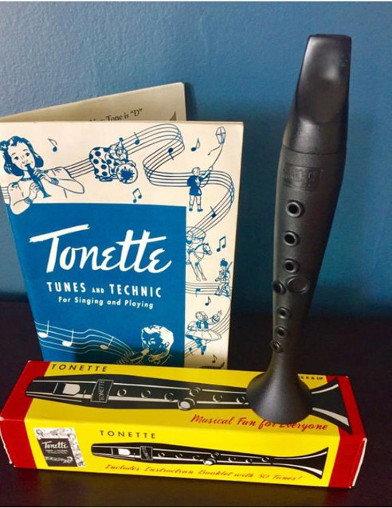
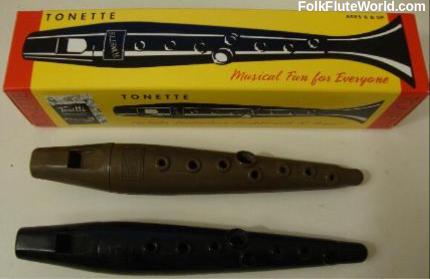
Tonettes (Left photo courtesy of Gibson, right photo by the author)
All tonettes are made of molded plastic. They either end with a bell, as shown above left, or in a bluntly rounded end, as on the right. Tonettes were made in various colors over the years, but for some reason black was by far most common.
Here are top and bottom views of a yellow tonette with a rounded end:
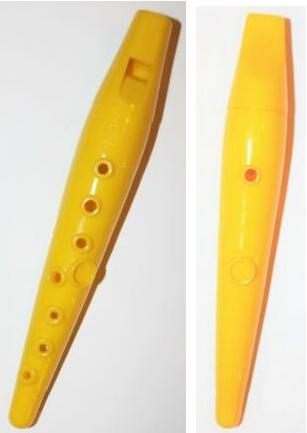
Top and Bottom Views of a Tonette (Photos courtesy of vendor iclaura at eBay)
Tonettes measure about eight inches long and an inch wide at their widest point. They have seven topside holes for players' fingers, and one bottom-side hole for the left-hand thumb. Note the two finger rests: one on top for the left-hand pinky finger, and one beneath for the right-hand thumb.
The mouthpiece is separate from the body. This allows for tuning
the instrument. Just slide the mouthpiece in or out to raise or lower the instrument's voice.
It also makes for easy cleaning -- just remove the
mouthpiece and wash in warm, soapy water.
If your instrument does not have a closed end, it's not a tonette.
Given its closed air chamber, the tonette is a type of vessel flute or ocarina. Vessel flutes work just like the pop bottles you blew into as a child. Your breath produces sound by air resonance within an enclosed space.
This differs from concert flutes, piccolos, recorders, and other flutes that have open ends. They're essentially open-ended tubes or pipes with fingering holes.
The tonette's unusual closed design yields its singular, rounded sound. Most musicians can discern that tonettes are not open-ended flutes when they hear them. Many claim that they sound like a cross between an end-blown flute and a ceramic ocarina.
Similar-looking plastic flutes that have open ends are not tonettes. For example, the competing song flute is frequently mistaken for the tonette:

Song Flutes (not Tonettes!) (Photos courtesy of Amazon)
The song flute features a gently-flared open end. Distinctive raised tracks connect the finger holes. The song flute is a different instrument with its own voice. (Learn more about it in my companion article here.)
Origins and History
The tonette was invented in the late 1930s by Ziegner Swanson. His goal was to develop a cheap, easy-to-play, cleanable plastic flute for children. The genius of his creation is that this simple instrument can serve as a vehicle for true musical expression as well.
The popularity of Swanson's invention exceeded his wildest dreams. By 1941, over half the nation's grammar school students learned tonette.
Educators believed that kids could learn musical basics by starting with an easy-to-play, inexpensive tonette. Then they would graduate to traditional concert instruments as they grew into their middle and high school years. Generations of youngsters tooted tonettes and then migrated to concert instruments.
During the second World War, the US Army distributed thousands of free tonettes to the troops. They favored it for the same reason educators did -- it was an easy-to-learn instrument that even those with no musical training could play. They judged that handing out free folk flutes was one way to keep the troops' morale high.
I had a close relative who received such a tonette and carried it all over China as he fought troops from the Empire of Japan. You can read the entire story here.
Identifying a Tonette
During its sixty year production run, several different companies manufactured and sold tonettes. They used different molds and plastics in production. So there are big quality differences among instruments. Some tonettes sound as beautiful as any flute you'll find; others toot like cheap children's toys.
All the tonettes carry an identifying stamp below the mouthpiece stating “Tonette”, “Swanson”, or “Gibson”. Tonette makers included The Tonette Company, Chicago Musical Instrument Co., Swanson, Gibson, Dimestore Dreams/Binary Arts Corp., and Restoration Hardware.
Competitors
During the tonette's heyday -- the 1940s through the 1980s -- its main competitors were the song flute and the flutophone. Together, these three flutes owned the market for pre-band instruments well into the 1970s.
The three instruments share similarities in pitch and fingering. Yet each has its own unique sound. (You can read a comparison of these flutes here.) Here's how to tell them apart:
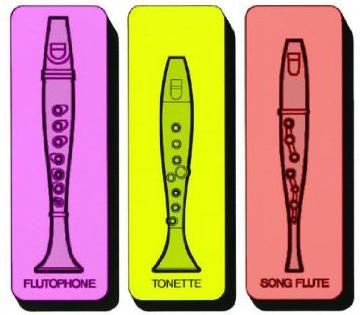
"Flutophone and Tonette for Beginners"
Inexpensive plastic recorders arrived in the '70s and '80s. Given their greater capabilities and wider musical range, they quickly grabbed the market away from the three traditional pre-band flutes.
Tonettes became relegated to a niche role in elementary education. Often they were considered little more than toys. Tonettes made in this late period are often cheap products with poor sound quality. The fun little flutes disappeared altogether by the turn of the century.
How to Play
Playing the tonette is simplicity itself. You blow into a fipple mouthpiece, similar to a recorder. There is no challenging embouchure to learn, nor is there a reed to adjust to.
Play the scale by covering all holes and progressively lifting your fingers. The raised lips on the holes make them easier to cover than those of a recorder.
Players instinctively calibrate their breath pressure to accurately sound notes. As with most ocarinas, you increase breath pressure a tad to hit the highest notes in tune. And, like most ocarinas, the highest note (all fingering holes open) has an airy sound.
Intonation varies by the manufacturer. Many tonettes hit whole notes accurately while pitch on the accidentals varies by the maker. But a real quality tonette will play the entire chromatic scale in tune.
The tonette's range is from C5 through D6. Its C5 base note is the same as that of the soprano recorder. That's one octave above middle C on the piano (C4).
You can play all sharps and flats within the range by cross-fingering (aka forked or split fingering). There is one exception: playing low C# requires covering half of the bottom-most hole. This is called half-holing. Musicians easily manage this but it takes a little practice to do it.
C5 through D6 is a pretty meager range: that's only nine whole notes. But you can easily extend it by two more notes -- up to F6 -- by taking a small penknife and hollowing out the two covered finger rests.
Remember, one finger rest is for the left-hand pinky finger, and the other is beneath the instrument, for the right-hand thumb. You can spot the finger rests in the photos of the yellow tonette we saw above.
This diagram shows their locations, and the photos show how a tonette looks with these holes hollowed out:
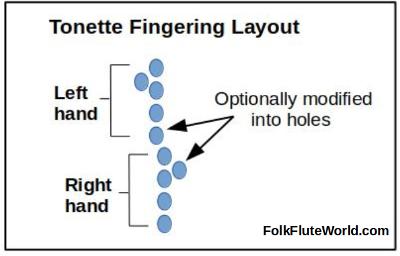
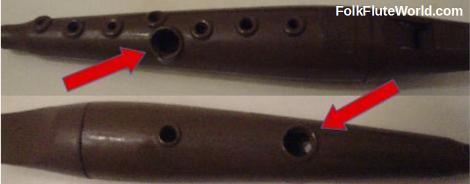
Given that it's so simple to extend the instrument's range, why weren't tonettes shipped this way? The answer is that one always covers these two holes when playing the basic scale. Hollowing them out extends the instrument's range on the high end -- but at the cost of adding cross-fingering. The fingering chart below makes this clear.
Inventor Ziegner Swanson chose to keep tonette fingering dead simple. This led to its great success as a training instrument. Swanson wisely allowed advanced players to extend the range by an easy modification.
I've never seen a complete C5-F6 fingering chart for the tonette, so I created this one. Notes to the right of the vertical red line are only playable if the finger rests have been altered into holes:
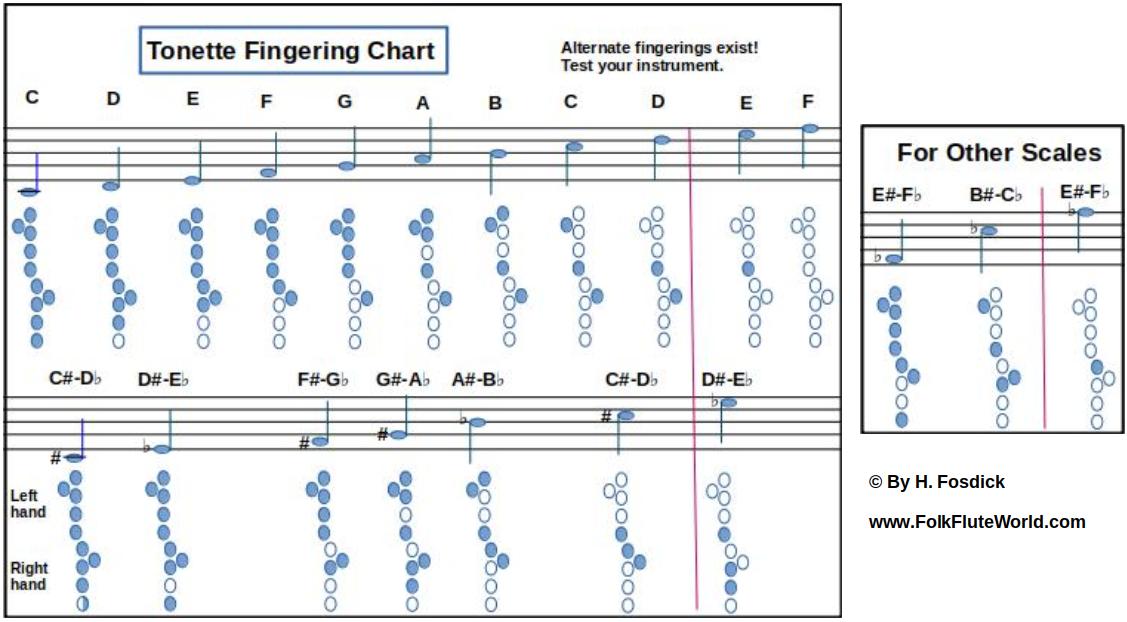
Alternate fingerings exist for several notes. Particularly with the sharps and flats you should experiment with your particular instrument to find its optimal fingerings.
To the right of the standard fingering chart I've added a few semitones I've found useful in working with certain non-western musical scales. These are not part of the standard fingering chart.
As with many ocarinas, a very skilled tonette player can obtain a half or even a whole note lower than one would think from the fingering charts. In the case of the tonette, the player quickly and carefully covers a bit of the open wind notch with his mouth, while blowing very softly. This isn't easy but one can perfect this unorthodox technique with practice.
Caring For Your Instrument
As a plastic instrument, the tonette needs little care and feeding. It's a good idea to take it apart and wash it in warm water occasionally. Your breath contains moisture that over time will accumulate and solidy inside the instrument; this will remove it.
You'll also want to take care not to expose the tonette to extremes of temperature. Don't leave it in a hot car window, for example, or it could sustain permanent damage.
Where to Get Free Sheet Music
All the sheet music you could ever want is available on the web for free. Beyond tonette music, you can play anything scored for common folk flutes including ocarina, song flute, flutophone, and precorder.
You can also play soprano recorder sheet music. However, given the recorder's greater range, some pieces stray outside what you can play on a tonette. You can adapt most of these songs by transposing them into a suitable key. A few tunes you may have to forgo.
Ditto for the tin whistle. Songs for the common D- and C- key penny whistles are playable unless they wander beyond the tonette's more limited range.
Just click here to access our extensive list of websites that offer free sheet music.
And click here for an extensive list of other resources for all folk flutes incuding tonette.
Selecting an Instrument
If you decide to buy a tonette, you'll have to look on the used market because they're no longer manufactured. The challenge to obtaining a good one is that they vary so dramatically in sound quality. How do you pick the gem out of the slag?
First, look for tonettes made from shiny, glossy plastic. These smooth-looking, highly reflective flutes inevitably sound better than those with less-reflective or matte finishes. Perhaps the shiny plastic is harder or denser and reflects sound waves differently? Whatever the case, you'll immediately notice the difference in voicing.
Second, I've generally found tonettes from the last decades of production to be inferior. I suspect that manufacturers had conceded the market to the recorder by this time and retreated to making cheap kid's toys. Avoid them if your goal is serious music. I'd recommend a tonette made prior to 1970.
Oddly enough, the market place doesn't seem to recognize this vast difference in tonal quality among tonettes. A gem will often be priced the same as an ill-tuned kid's toy in the used market.
Ultimately the only way to ensure you acquire a quality instrument is to play it prior to purchase. Or, listen to a recorded sound sample of the instrument you are considering for purchase.
Final Words
I like tonettes because they offer another flute with its own unique sound. It's fun to have a varied set of folk flutes and tonettes are an essential part of my collection.
I find them handy for composing. It's a lot easier to be creative when you're not managing a complex concert instrument like a concert flute or saxophone.
For only $15 or $20 you can acquire a fun little vehicle to hours of musical pleasure. You'll quickly enjoy proficiency and discover a unique new sound with which to experiment. Why not give it a try?
==> You might also be interested in my article My Tonette Goes to War, the true story of a 1943 US Army tonette I inherited.
***** SUMMARY *****
Instrument: Tonette
Material: Plastic
Manufacturer: Several over the years including Swanson, Gibson, and Binary Arts
Pitch: C major (aka "alto C" ocarina)
Range: C5 - D6. C5 to F6 with simple modification.
Tunable: Yes
Chromatics: All but low C# (which must be half-holed)
Fingering: Simple (recorder-like)
Construction: Washable plastic, two piece construction
Length: apx 7.5 to 8 inches (depending on whether bell is attached)
Weight: apx 1.6 ounce
Cost: Varies, must be purchased used from Ebay, Etsy, or similar source
Material: Plastic
Manufacturer: Several over the years including Swanson, Gibson, and Binary Arts
Pitch: C major (aka "alto C" ocarina)
Range: C5 - D6. C5 to F6 with simple modification.
Tunable: Yes
Chromatics: All but low C# (which must be half-holed)
Fingering: Simple (recorder-like)
Construction: Washable plastic, two piece construction
Length: apx 7.5 to 8 inches (depending on whether bell is attached)
Weight: apx 1.6 ounce
Cost: Varies, must be purchased used from Ebay, Etsy, or similar source
***** COMPARISON CHART *****
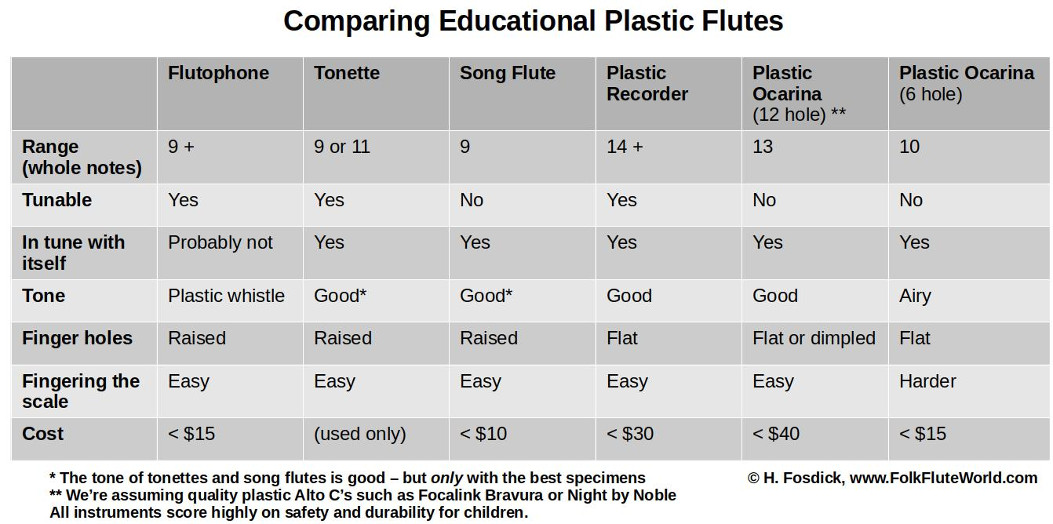
***** GALLERY *****

US Army Tonette Issued 1943 -- Read Its True Story Here
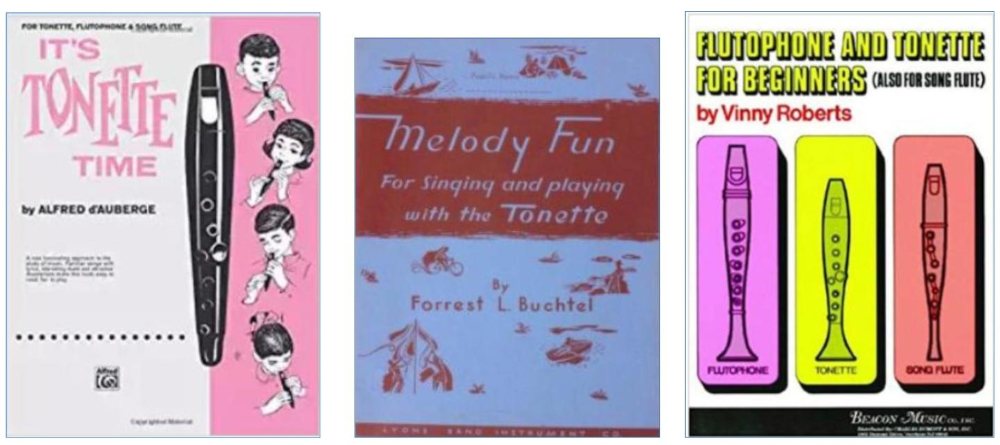
Tonette Instructional Booklets (Courtesy Amazon)
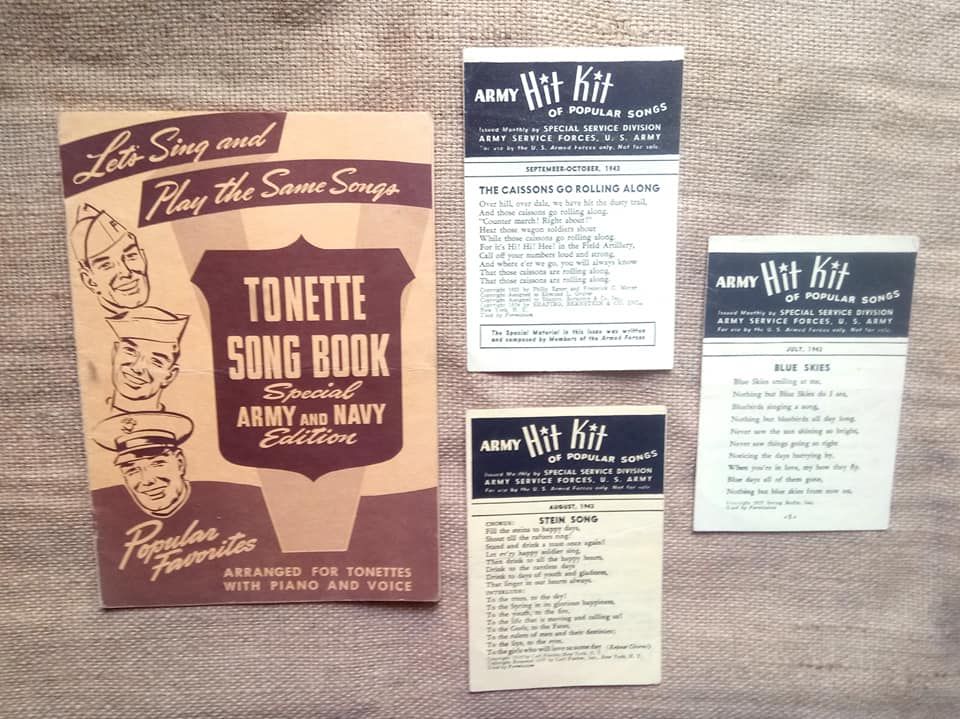
US Army WWII Tonette Booklets (Courtesy eBay)
Tonette Boxes (Photos by the author)

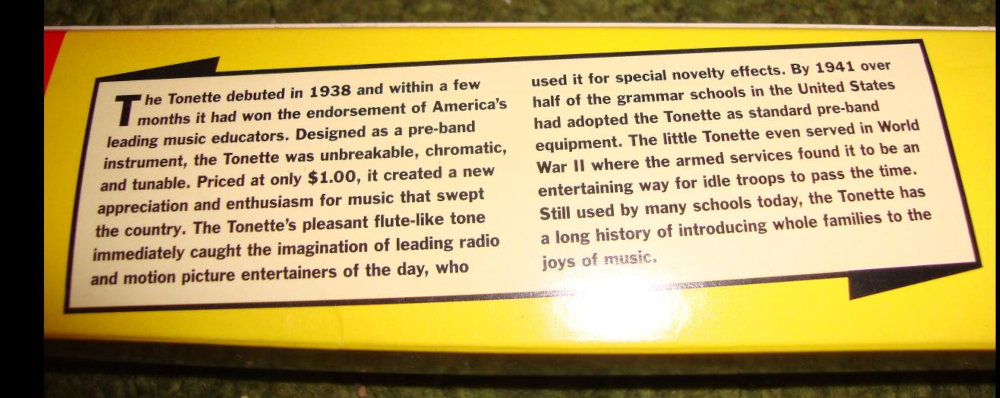

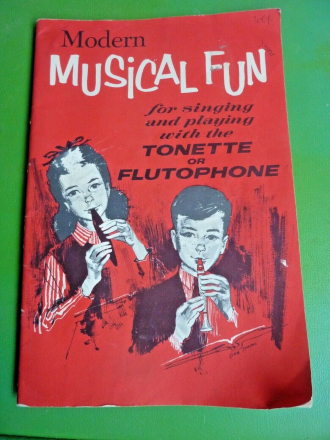
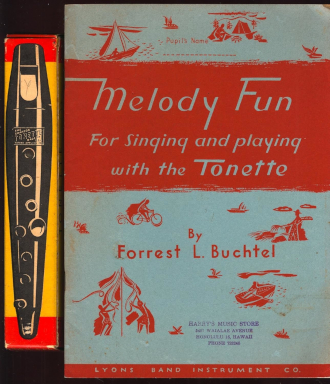

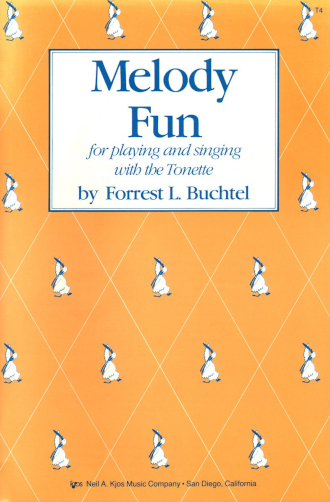
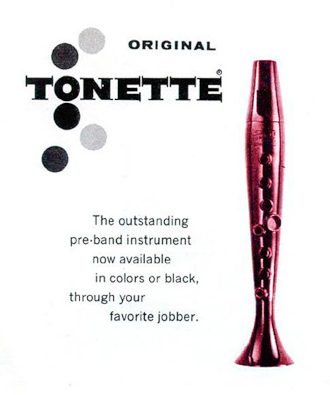
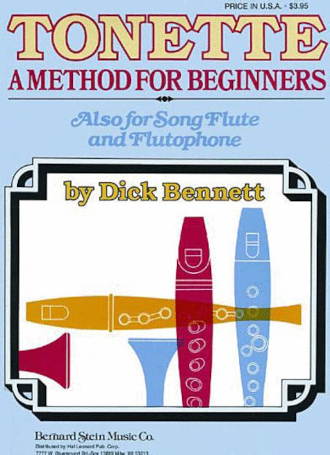
Tonette Instructional Booklets (Courtesy Amazon)
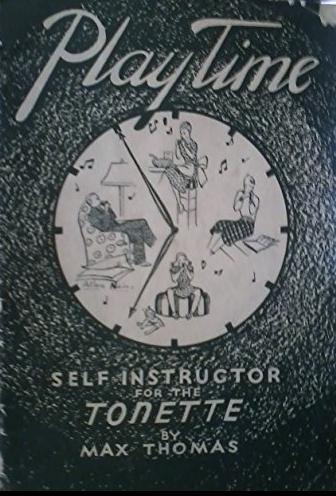
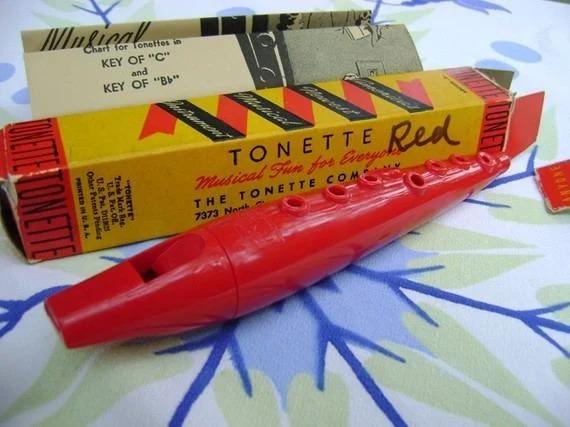
Tonette Instructional Booklet and Tonette Package (Courtesy Amazon and Alchetron)
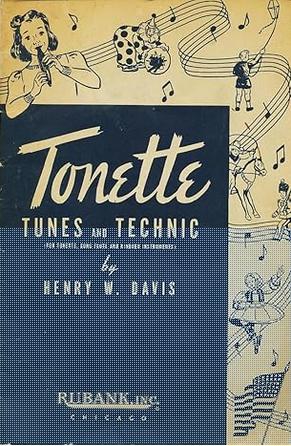
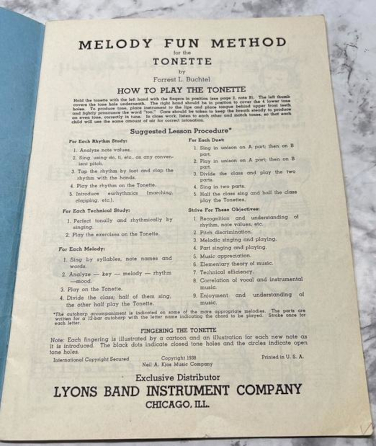
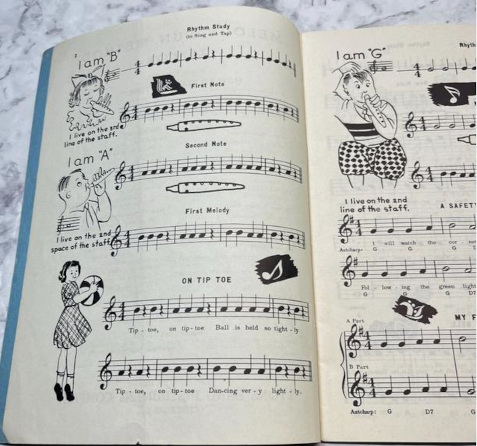
Tonette Instructional Booklets (Courtesy Ebay)

Tonette Box (Courtesy TapsBugler.com)
"The Flute Player" -- Original Oil on Canvassboard Painting by Carol Flatt (carolflatt.blogspot.com)

---------------------------
Like this article? Tell others at Slashdot, Digg, Reddit, or post on your favorite social media. Thanks!